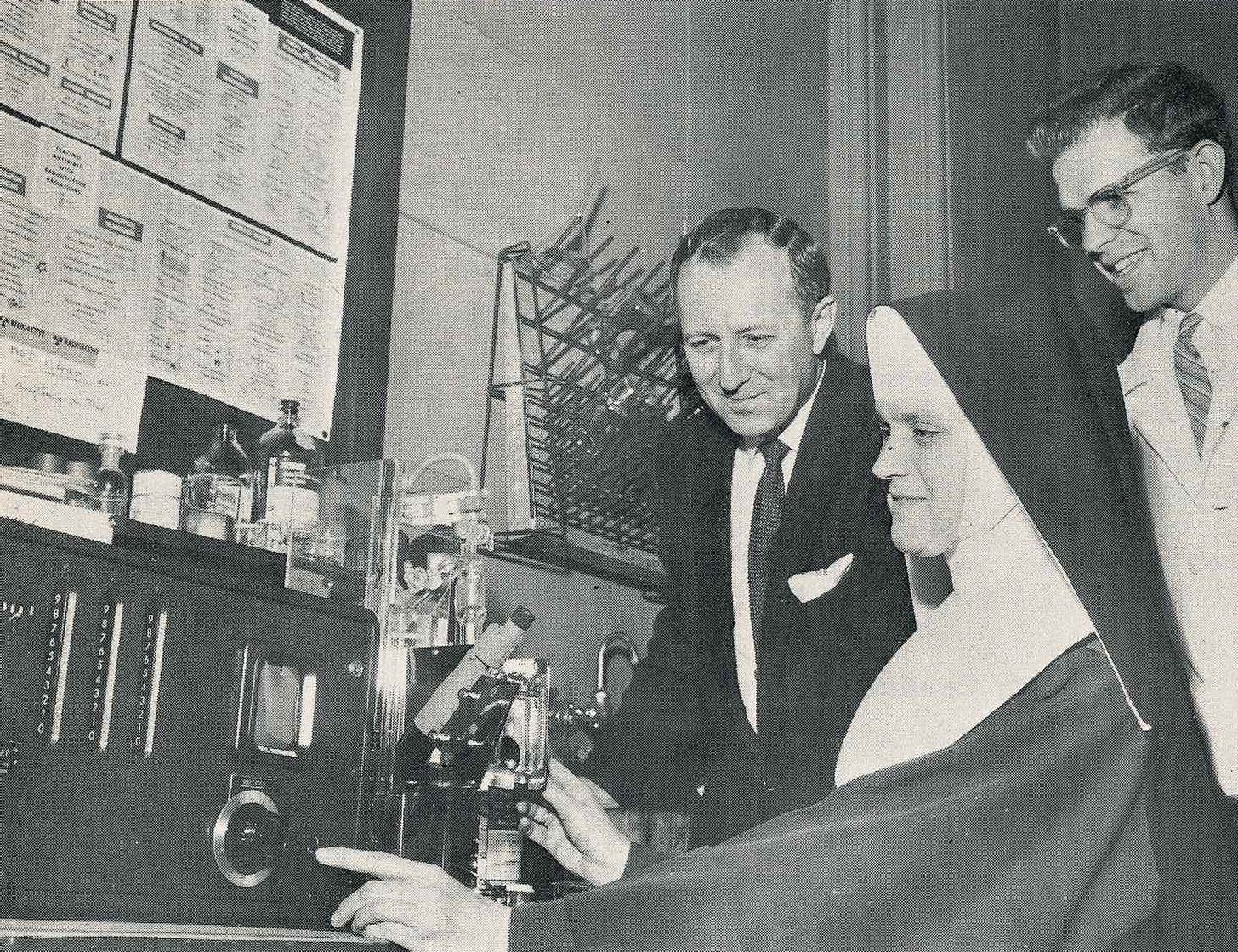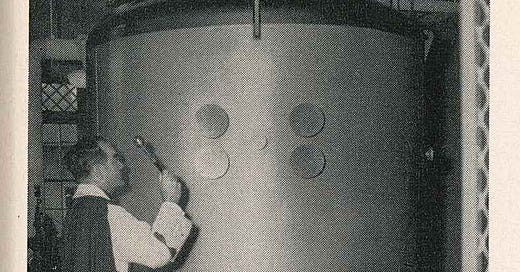The other day, Tucker Carlson spouted some insane nonsense about how nuclear technology was not created by humans — and because nuclear has a questionable origin story, it was probably derived from demonic influence. Or something.
I don’t get what he’s driving at and I don’t want to get in the car with him to find out. It’s my firmly held belief that when someone becomes famous enough in news media, their brain begins to leak out of their ears while they sleep until it’s all gone. It doesn’t matter which party you belong to—Media Fame Brain Leak Syndrome (MFBLS) is a bi-partisan condition. Pray that I never become too successful, will you?
Anyway, I won’t debate Tucker on the merits because there’s no point.
The upshot of all this, however, is that a reader took the occasion of Tucker’s Nuclear Pazuzu Hypothesis (NPH) to send me an incredible missive culled from the archives at Catholic University of America, where the Atomic Energy Commission built a small test reactor.
The photos are incredible. Industrial Cathedrals indeed.

Shane MacDonald, who gave this history a tidy write-up, lays out the origins of Catholic University’s Atom Smasher:
In the fall of 1957, an AGN-201 nuclear training reactor was installed on the Catholic University campus. Originally located in the Nuclear Training Laboratory of the campus Power Plant, this reactor was a compact unit standing nine feet tall and weighing 12 tons. Capable of producing 100 milliwatts of energy – only enough to light a single Christmas tree bulb! – the unit was not intended for powering campus offices but providing a controlled model to train budding nuclear engineers, power plant operators, and faculty researchers. For over 20 years, the reactor was at the heart of a close relationship between the Atomic Energy Commission (AEC) and the University.
This effort was part of Eisenhower’s Atoms for Peace initiative to harness the doom-thundering power of the atom to bring on a brighter future.
For those interested, you can read MacDonald’s brief history of the Catholic Atom Smasher here.
Suffice to say, the alleged conflict between science and religion, faith and reason is little more than Enlightenment propaganda, a subject we’ve been exploring in our podcast series on the Esoteric Origins of the Enlightenment, the last episode of which comes out this weekend. (Start listening here!)
I should also add that my very smart friend
has recently published a book concerning the science v. faith question, Light of the Mind, Light of the World: Illuminating Science Through Faith. I highly recommend buying and reading it for two reasons: (1) it’s quite good; (2) Spencer is returning to the pod to talk about it.Before I let you go, I wanted to leave you with this tidbit from Theodore Rockwell’s The Rickover Effect: How One Man Made A Difference. In it, Rockwell gives a brief narration of his time working for the Manhattan Project at Oak Ridge Lab. Much of the labor force was pulled from rural Tennessee. Many of them had only very recently experienced the wonders of electricity in their homes thanks to the Tennessee Valley Authority. This is all to say, these people weren’t educated, but that didn’t mean they weren’t smart.
To emphasize that fact, Rockwell relays a touching anecdote about the local ladies who operated the Herculean magnets at Oak Ride:
Many, if not most, were young women who had not graduated from high school and had been trained for the job with a wholly false story as to what was going on. To the young physicists from Brooklyn, these “hillbilly girls” with their Daisy Mae accents and casual personalities seemed totally incapable of carrying out the awesome responsibility entailed in operating these sophisticated machines.
One day, Rockwell paused to consider if these young women had the wits to truly master these devices. But then he remembered that he “had seen these operators develop an intuitive sensitivity to the equipment” and “had seen them get a unit purring again after a Ph.D. scientist had botched an effort to improve performance.”
And here’s the part that really got me:
These women personified their units and complained bitterly if they were forced for personnel reasons to operate a different unit (one that any scientist would tell you was identical). When one of the production buildings was shut down after the war, the operators wrote sentimental notes and farewell poems with lipstick on their instrument panels, and shed tears of sorrow at the forced separation from the esoteric devices with which they had developed such a strange and productive relationship.
Maybe there are machine spirits after all…







All throughout the medieval and Renaissance years, cathedral building was people's major activity that had lasting results.
I have seen a person or two propose building 100 or 1000 reactors for a complete overhaul of America's energy system. That would resemble the situation across Europe hundreds of years ago where almost everyone (mostly male) was a builder.
Nuclear Energy saves lives, both by the energy it produces and because it is the safest source of energy. Au contraire to what Tucker Carlson said, it could be said that nuclear energy, based on the fundamental makeup of matter, is the energy source that God ordained. And, like Eve in the garden humanity encountered the question of good and evil at the dawn of nuclear energy.
I've been in my local cathedral when Dr. Fitzgerald (our organist) is playing a particularly glorious piece and I've thought, "Is this the time that the Lord has set for the rebirth of... industrial cathedrals?